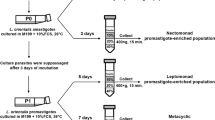Summary
Hamster peritoneal macrophages were infected with arivulent and virulent promastigotes of aL. donovani strain using various ratios (1∶1; 1∶10) of parasites and peritoneal cells. Light microscope studies have shown that there was a significant difference in the number of parasites taken up by phagocytic cells between the macrophage cultures infected with avirulent and virulent promastigotes at 4 h as well as during the following 14 days of infection. In both virulent groups the number of amastigotes were sharply increased. However, the surviving parasites were eliminated continuously when the macrophage cultures were infected with avirulent parasites. Electron microscope examinations of the different infected macrophage cultures did not show any difference in the localization of the surviving parasites. At one and 24 h post-infection, parasites have been observed in typical parasitophorous vacuoles. However, by day 4, 7, and 14 post-infections, the majority of intact parasites were surrounded by a four-laminar membrane without a space between parasite and vacuole membrane. Besides, some amastigotes were seen in large parasitophorous vacuoles. It seemed as if some of these amastigotes were trying to leave the parasitophorous vacuoles. In all cases acid phosphatase could be demonstrated in the parasitophorous vacoules and around the parasites indicating that the lysosomes of the host cell have been fused with the parasitophorous vacuole. It is indicated that the virulentLeishmania parasites are more resistant to the digestive system of the macrophages.
Similar content being viewed by others
References
Akiyama, H.J. McQuillen, N.K.: Interaction and transformation ofLeishmania donovani within in vitro cultured cells. Am. J. Trop. Med. Hyg.21, 873–879 (1972)
Alexander, J., Vickerman, K.: Fusion of host cell secondary lysosomes with the parasitophorous vacuoles ofLeishmania mexicana infected macrophages. J. Protozool.22, 502–508 (1975)
Chang, K.P., Dwyer, D.M.:Leishmania donovani. Hamster macrophage interactions in vitro. Cell entry, intracellular survival, and multiplication of amastigotes. J. Exp. Med.147, 515–529 (1978)
Ebert, F.: Charakterisierung vonLeishmania donovani-Stämmen mit der Disk-Elektrophorese. Z. Tropenmed. Parasitol.24, 517–524 (1973)
Ebert, F., Enriquez, G.L., Mühlpfordt, H.: Electronmicroscopic studies of phagocytosis ofLeishmania donovani by hamster peritoneal macrophages and its lysosomal activity in vivo. Behring Inst. Mitt.60, 65–74 (1976)
Handman, E., Spira, D.T.: Growth ofLeishmania amastigotes in macrophages from normal and immune mice. Z. Parasitenkd.53, 78–81 (1977)
Jones, T.C., Hirsch, J.G.: The interaction betweenToxoplasma gondii and mammalian cells. II. The absence of lysosomal fusion with phagocytic vacuoles containing living parasites. J. Exp. Med.136, 1173–1193 (1972)
Kress, Y., Tanowitz, H., Bloom, B., Wittner, M.:Trypanosoma cruzi: Infection of normal and activated mouse macrophages. Exp. Parasitol.41, 385–396 (1977)
Lewis, D.H., Peters, W.: The resistance of intracellularLeishmania parasites to digestion by lysosomal enzymes. Ann. Trop. Med. Parasitol.71, 295–312 (1977)
Miller, H.C., Twonhy, D.W.: Infection of macrophages in culture by leptomonads ofLeishmania donovani. J. Protozool.14, 781–789 (1967)
Nogueira, N., Cohn, Z.:Trypanosoma cruzi: Mechanism of entry and intracellular fate in mammalian cells. J. Exp. Med.143, 1402–1420 (1976)
Pulvertaft, R.J.V., Hoyle, G.F.: Stages in the life cycle ofLeishmania donovani. Trans. R. Soc. Trop. Med. Hyg.54, 1910196 (1960)
Rudzinska, N.A., D'Alessandro, P., Trager, W.: The fine structure ofLeishmania donovani and the role of kinetoplast in the leishmania-leptomonad transformation. J. Protozool.11, 166–191 (1964)
Snedecor, G.W., Irwin, M.R.: On the Chi-square test for homogeneity. Iowa State College. J. Sci.8, 75–81 (1933)
Author information
Authors and Affiliations
Rights and permissions
About this article
Cite this article
Ebert, F., Buse, E. & Mühlpfordt, H. In vitro light and electron microscope studies on different virulent promastigotes ofLeishmania donovani in hamster peritoneal macrophages. Z. Parasitenkd. 59, 31–41 (1979). https://doi.org/10.1007/BF00927844
Received:
Issue Date:
DOI: https://doi.org/10.1007/BF00927844




